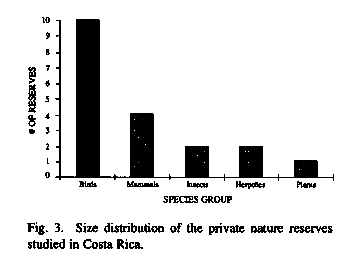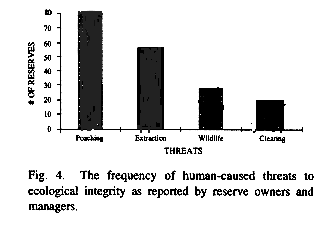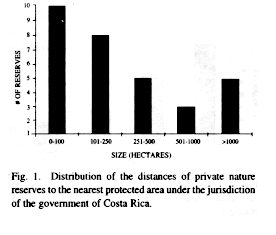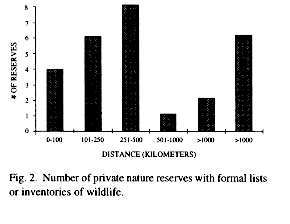Services on Demand
Journal
Article
Indicators
-
 Cited by SciELO
Cited by SciELO -
 Access statistics
Access statistics
Related links
-
 Similars in
SciELO
Similars in
SciELO  uBio
uBio
Share
Revista de Biología Tropical
On-line version ISSN 0034-7744Print version ISSN 0034-7744
Rev. biol. trop vol.46 n.2 San José Jun. 1998
Conservation efforts to preserve biological diversity are often focused on the establishment of protected areas such as national parks, wildlife refuges and forest reserves (McNeely et al. 1990, WRI, IUCN, UNEP 1992) under government control. Boza (1993) identified the need for innovative partnerships to ensure the maintenance of these areas in Costa Rica. Since ecotourism is viewed as a major benefit derived from the protection of these areas and a strong incentive to acquire new lands to complete the system (Boza 1993), a conservation link with the tourist industry would be attractive.
Numerous authors have examined the benefits and drawbacks to such a relationship (Boo 1990, Rovinski 1991, Giannecchini 1993, Burnie 1994). In the typical scenario, increasing levels of visitation by ecotourists to protected areas ideally generates revenue from entrance fees and services while contributing to local and national economies via employment, the development of infrastructure and exchange of foreign currency. However, the expansion of ecotourism also leads to problems associated with overcrowding, disturbance of wildlife (Damon and Vaughan, 1995) and the limited carrying capacity of reserves to sustain ever higher levels of visitation.
This growth pattern has been dramatically demonstrated in Costa Rica where visitation to national parks is rising at 25-30% per annum (Bermudez & Mena 1992). The demand for ecotourism has also led to the rapid establishment of nature reserves on private land. Other reasons for the establishment of private reserves in Costa Rica include: the protection of biodiversity, cultural and economical reasons (Chaverri 1979, Fournier and Herrera de Fournier 1979, Gonzalez 1985, Fournier 1991, Fournier 1992).
Can private reserves complement government efforts to protect biological diversity? We examined this possibility by assessing (1) physical characteristics; (2) species occurrence, primarily of birds and mammals; and (3) threats to the ecological integrity of individual reserves.
We established a list of nature reserves by reviewing travel guides, advertisements in newspapers and promotional materials from travel agencies. Reserves were selected using the following criteria: (1) private land ownership; (2) current business plan based on ecotourism; (3) site development financed without government or donor support; and (4) profit based operation. These criteria eliminated biological stations established by educational institutions and reserves created with the assistance of international fund-raising campaigns.
We visited each reserve and surveyed the site, frequently with biologists and guides who collected biological information. We obtained two types of species inventory data from these individuals: observational checklists of species occurrence often available to tourists, and personal records of wildlife sightings, particularly in relation to a predetermined list of 14 mammals. We determined reliability of this data by assessing qualifications and experience of observers and techniques for data collection and storage.
Interviews were conducted with the owner or manager of each reserve to determine site development, history, surrounding land use activities and community acceptance. Whenever possible, interviews were conducted in the field.
Locations of private reserves were plotted on topographic maps (1: 200,000). Distances were calculated to the nearest protected areas identified by Boza (1993).
We reviewed 41 potential reserves: 9 areas failed to meet our criteria and we were unable to obtain information from 6 other candidates. Our survey was extensive and included reserves throughout Costa Rica.
Physical Characteristics: The 26 reserves (Table 1) ranged in size from 20-1,492 ha and encompassed 10,124 ha. Average reserve size was 389 ha (S.D. = 471). Twenty reserves (77%) were less than 500 ha in size (Fig. 1).
Four reserves were adjacent to protected areas under the jurisdiction of the government of Costa Rica (Fig. 2). The average distance of the other 22 reserves to government -controlled areas was 12.4 km (S.D. = 11.1). The range of distances to nearest protected area was 0.5 - 33.2 km.
Biological Inventory: Species checklists were primarily available for birds (Fig. 3). Eight of the bird lists were simple checklists of presence only while the other 2 included both checklists and information on breeding status and seasonal patterns of abundance. Three additional lists were excluded from our analysis because they included species observed outside reserve boundaries.
The average number of birds/list was 200 (S.D. = 78) ranging from 86 to 333 species. A total of 645 different species of birds were identified at the 10 reserves, 74% of the Costa Rican avifauna (Stiles and Skutch 1989). Nearly all of the endangered avifauna in Costa Rica were found in private nature reserves: of the 27 species listed by Sanchez and Quesada (1989), 21 species (78%) were reported in our survey. All members of the Accipitridae and Falconidae are also considered endangered: 76% and 85% of the species in these families have been observed at private reserves. Except for the spotted-breasted oriole (Icterus pectoralis), species absent from reserves all require extensive wetland habitats that did not exist at private reserves.
Only 4 reserves (19%) had lists of mammals (Fig. 2). These lists included 47, 33, 26 and 19 species, respectively and were dominated by species of interest to tourists and reserve managers (e.g., non-primates, large carnivores, sloths). Non-human primates are endangered species in Costa Rica (Sanchez & Quesada 1989) and records were available from 20 additional reserves for these highly visible species.
| | ||||
| | ||||
| | | | | |
| Rara Avis | | | | |
| Sarapiqui Ecolodge | | | | |
| Selva Verde | | | | |
| El Gavilan | | | | |
| Oro Verde | | | | |
| Ecoadventure Lodge | | | | |
| Arenal Observatory Lodge | | | | |
| Villa Blanca Hotel | | | | |
| Los Innocentes | | | | |
| Curu | | | | |
| Dundee Ranch Hotel | | | | |
| Carara Ecological Hotel | | | | |
| Hacienda Baru | | | | |
| Cabanas Escondidas | | | | |
| El Salto Biological Reserve | | | | |
| Marenco Reverse | | | | |
| Campanario | | | | |
| Corcovado Tent Camp | | | | |
| Tiskita Lodge | | | | |
| Alberque de Montaña -Cabinas Chacon | | | | |
| Finca de los Quetzales | | | | |
| Genesis II | | | | |
| Rancho Naturalista | | | | |
| Totuga Lodge | | | | |
| Avarios Caribe | | | | |
| Chimuri | | | | |
Size in hectares
Year initiated
Distance to nearest public protectec area
Holdridge Life Zone: bh-T=tropical wet forest, bmh-T=tropical very wet forest, bmh-P=premontane very wet forest,
bp-MP=lower montane rain forest, bp-M=montane rain foest.

With respect to non-human primates, the white-faced capuchin (Cebus capucinus) was the most common, found in 79% of reserves; while howler monkeys (Alouatta palliata) were also present at most reserves (75%). Spider monkeys (Ateles geoffroyi) were less common (13 reserves, 54% of sites). Squirrel monkeys (Saimiri oestedii) were reported at only 4 sites (17%) but did occur at 67% of the reserves located within the known in-country range of the species.
Several other species were reported from 19 reserves. The jaguar (Panthera onca) and puma (Felis concolor) were only present at 6 (32%) and 3 (16%) reserves (N=19), respectively. In contrast, ocelot (Felis paradalis) and margay (Felis wiedi) were more common (14 and 13 reserves, 74% and 68% respectively). Jaguarundi (Felis yagouaroundi) were known from observations at 11 (58%) reserves. Since the little spotted cat or oncilla (Felis tigrina) was reported on one of 4 mammal lists, private nature reserves provided habitat for the 6 known felids in the country, all of which are endangered (Sanchez & Quesada 1989).
Two caviomorphs, the agouti (Dasyprocta punctata) and paca (Agouti paca) were present at nearly all 19 sites; agouti were recorded at 18 sites while 16 reserves reported the presence of paca. The collared peccary (Tayassu tajacu) was also present at 16 reserves (84%) while the white-lipped peccary (Tayassu pecari) was very uncommon (3/19, 16%). The latter species is endangered in Costa Rica (Sanchez & Quesada 1989) as is the tapir (Tapirus bairdii), a species present at 7 of 19 reserves (37%).
An additional 14 species of mammals are listed as endangered species in Costa Rica (Sanchez and Quesada 1989). Nine of these species including the giant anteater (Myrmecophaga tridactyla), collared anteater (Tamandua mexicana), silky anteater (Cyclopes didactylus), two-toed sloth (Choleopus hoffmani), three-toed sloth (Bradypus variegatus), Deppe's squirrel (Sciurus deppei), grison (Galictis vittata), southern river otter (Lutra longicadus) and kinkajou (Potos flavus) were known to occur at private nature reserves.
Threats to Ecological Integrity: Illegal hunting of wildlife was the most common negative activity reported by reserve managers (Fig. 4). Poaching occurred at 20 reserves (77%) and was considered to be a potential threat at 3 of the other 6 sites. In most cases, paca was the primary species sought by hunters. Ocelot and deer were also hunted at individual reserves.
The extraction or removal of forest products was considered to be a threat at 14 reserves (54%). The cutting of "palmito" or heart of palm was reported as a common problem. The harvest of orchids and cutting of trees for charcoal production were also noted as threats to the biodiversity of reserves.

Wildfire was considered a serious threat at 7 reserves (27%). These reserves were located in regions where extended dry seasons prevailed and where fires could either escape from neighbouring lands or result from arson.
Four reserves (15%) had suffered habitat loss or degradation due to illegal settlement by squatters. Managers of reserves were generally confident a combination of vigilance and community involvement in business operations would prevent or curtail such invasions. Similar strategies were also viewed as a means to reduce illegal hunting and extraction.
Analysis: Individual reserves contribute, most obviously, to the protection of biodiversity in Costa Rica by providing habitat for endangered species. Some of these species are not well protected in government reserves: the squirrel monkey occurs at 4 private reserves but is only present in 2 of the areas identified by Boza (1993). Similarly, the scarlet macaw (Ara macao) occurs at only 3 protected areas in Costa Rica (Vaughan et al. 1991), but inhabits 4 private reserves. By protecting endangered species and other species that exist as metapopulations (Wilson 1992), private reserves effectively expand the conservation efforts of the government and international organizations.
This effect is readily apparent when reserves dedicated to ecotourism are located in the buffer zones of protected areas. Several advantages can result from this relationship, including an expanded sphere of protected habitat (Shafer 1990, Sayer 1991, Imback & Godoy 1992), a reduction in negative ecological edge effects (.Saunders et al 1991), and increased security from disturbances like poaching. Indeed we noted all human threats to ecological integrity were offset by the greater vigilance of staff at private reserves as well as higher levels of community support for these reserves compared to their government counterparts.
The collective importance of the reserves we studied is demonstrated by our assessment of bird species richness. Despite the availability of records from only 38% of the reserves, 74% of the avifauna were reported to occur at these sites. We believe this remarkable Fig. reflects the unique ecological characteristics of individual reserves and their country-wide distribution. Furthermore, since riparian zones and extensively forested areas exist within their boundaries, we suspect many reserves serve as biological corridors for migration and dispersal. The resplendent quetzal (Pharomachrus mocinno), great green macaw (Ara ambigua) and three-wattled bellbird (Procnias tricarunculata) are 3 species that migrate along elevational gradients (Stiles & Clark 1989, Stiles & Skutch 1989) and may reside temporarily at private reserves.
Reserve size and degree of isolation from other protected areas undoubtedly influenced the species occurrence of mammals at individual reserves. The general absence of jaguar and puma supports the contention by Terborgh (1992) that neotropical forest fragments less than 1000 ha in size (85% of our reserves) will ultimately lose resident populations of these area-demanding species (Emmons 1990). If the lack of these keystone predators leads to a release of prey species that function as seed predators to decrease the diversity of forest vegetation (Terborgh 1992), private reserves are potentially at risk. Only 1 reserve did not report the presence of agouti, paca or peccary (76% had all 3 species, 90% a combination of any 2 species) yet only 7 reserves had sightings of jaguar or puma. Maintaining wide-ranging species at private reserves will require the regional integration and management of all types of protected areas.
Private reserves may be located in ecoregions poorly represented in the government system and in regions of the country without existing reserves. We believe their inclusion into the existing network of traditional protected areas is overdue given the continual pressures of economic development in Costa Rica (Hunter 1994). The challenge will be for government managers to design plans that incorporate these areas into the gaps present in the current system (Chaverri 1979, Fournier y Herrera de Fournier 1979, Boza 1993). Land preservation generated by ecotourism can complement efforts by the government to safeguard biological diversity. However, in some cases, especially where reserves are local family-owned businesses, technical support and funding from international conservation organizations may be appropriate to ensure the long-term protection of the biodiversity represented by these often unique parcels of the tropical environment.
We thank the owners and managers of the nature reserves we visited for their hospitality and the many individuals who provided information and personal records on wildlife, especially Giovanni Bello Carranza and Jim Zook. Royal Jackson participated in many of the interviews and we appreciate his assistance. This project was completed while the senior author was on leave from Lethbridge Community College, Alberta, Canada.
References
Bermudez, F. & Y. Mena. 1992. Parques nacionales de Costa Rica. Oficina de Planificacion y Servicios Tecnicos, Ministerio de Recursos Naturales, Energía y Minas, San Jose, Costa Rica. [ Links ]
Boo, E. 1990. Ecotourism: the potential and pitfalls. World Wildlife Fund, Washington, D.C. [ Links ]
Boza, M.A. 1993. Conservation in action: past, present, and future of the national park system of Costa Rica. Cons. Biol. 7: 239-247. [ Links ]
Burnie, D. 1994. Ecotourists to paradise. New Sci. April 16, pages 23-27. [ Links ]
Chaverri, A. 1979. Análisis de reservas biolígicas privadas en Costa Rica. Tesis M.S. CATIE, Turrialba, Costa Rica. [ Links ]
Damon, T. and C. Vaughan. 1995. Ecotourism and wildlife conservation in Costa Rica: Potential for a sustainable partnership. Pages 211-216 - in J. Bissonette and P. Krausman (eds.). Integrating People and Wildlife for a Sustainable Future. The Wildlife Society. Bethesda, Maryland. [ Links ]
Emmons, L.H. 1990. Neotropical rainforest mammals. The University of Chicago, Chicago, Illinois. 281 p. [ Links ]
Fournier, L. 1991. Recuperación y mantenimiento de la diversidad biológica en el cantón de Mora, Costa Rica. Resumenes del Tercer Congreso Nacional de Biología. San José, Costa Rica. [ Links ]
Fournier, L. 1992. Establishmiento de pequeñas reservas naturales mediante la regeneración natural y su importancia en el desarrollo. Plenario del II Simposio de Ecología, Turismo y Municipio. Instituto Costarricense de Turismo, San José. p.12. [ Links ]
Fournier, L & M. Herrera de Fournier. 1979. Importancia científico, económica y cultural de un sistema de pequeñas reservas naturales en Costa Rica. Agron. Cost. 3: 53-55. [ Links ]
Giannecchini, J. 1993. Ecotourism: new partners, new relationships. Cons. Biol. 7: 429-432. [ Links ]
Gonzalez, R. 1985. El establecimiento y los cuidados de las pequeñas áreas boscosas. Universidad Estatal a Distancia, San José. 46 p. [ Links ]
Hunter, J.R. 1994. Is Costa Rica truly conservation-minded? Cons. Biol. 8: 592-595. [ Links ]
Imbach, A.C. J.C. Godoy. 1992. Progress in the management buffer zones in the American tropics: proposals to increase the influence of protected areas. Parks 3: 19-22. [ Links ]
McNeely, J.A., K.R. Miller, W.V. Reid, R.A. Mittermeir T.B. Werner. 1990. Conserving the world's biological diversity. International Union for Conservation of Nature and Natural Resources, Gland, Switzerland. World Resources Institute, Conservation International, World Wildlife Fund-US, and the World Bank, Washington, D.C. [ Links ]
Rovinski, Y. 1991. Private reserves, parks, and ecotourism in Costa Rica. Pages 39-57 in T. Whelan, editor. Nature tourism: managing for the environment. Islan, Washington, D.C. [ Links ]
Sanchez, O. & A. Quesada. 1989. Lista de especies en vías de extinción y temporadas de caza. Servicio de Vida Silvestre, Ministerio de Recursos Naturales, Energía y Minas, San Jose, Costa Rica. [ Links ]
Saunders, D.A., R.J. Hobbs C.R. Margules. 1991. Biological consequences of ecosystem fragmentation: A review. Cons. Biol. 5: 18-32. [ Links ]
Sayer, J. 1991. Rainforest buffer zones: guidelines for protected area managers. International Union for Conservation of Nature and Natural Resources, Gland, Switzerland. [ Links ]
Shafer, C.L. 1990. Nature reserves: island theory and conservation practice. Smithsonian Institutio, Washington, D.C. [ Links ]
Stiles, F.G. D.A. Clark. 1989. Conservation of tropical rain forest birds: a case study from Costa Rica. Am. Birds 43: 420-428. [ Links ]
Stiles, F.G. A.F. Skutch. 1989. A guide to the birds of Costa Rica. Cornell University, Ithaca, New York. [ Links ]
Terborgh, J. 1992. Maintenance of diversity in tropical forests. Biotropica 24: 283-292. [ Links ]
Vaughan, C., M. McCoy & J. Liske. 1991. Scarlet macaw ecology and management perspectives. Pages 23-34 in J. Clinton-Eitniear (ed.). Proceedings of the first Mesoamerican workshop on the conservation and management of macaws. Center for the Study of Tropical Birds, San Antonio, Texas. [ Links ]
Wilson, E.O. 1992. The diversity of life. Harvard University, Cambridge, Massachusetts. [ Links ]
World Resources Institute (WRI), The World Conservation Union (IUCN) and United Nations Environment Programme (UNEP). 1992. Global Biodiversity Strategy. [ Links ]
1Present address: Department of Environmental Science, Lethridge Community College, 3000 College Drive South, Lethbridge, AB T1K 1L6, Canada.
2 Regional Wildlife Management Program for Mesoamerica and the Caribbean, Universidad Nacional, Heredia, Costa Rica, tel. 506-277-3544, fax 506-237-7039, email: cvaughan@irazu.una.ac.cr
















